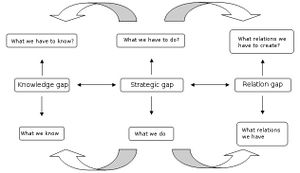Knowledge gap strategy: Difference between revisions
(Infobox update) |
(The LinkTitles extension automatically added links to existing pages (<a target="_blank" rel="noreferrer noopener" class="external free" href="https://github.com/bovender/LinkTitles">https://github.com/bovender/LinkTitles</a>).) |
||
| Line 34: | Line 34: | ||
# Analysis of internal [[business environment]]. | # Analysis of internal [[business environment]]. | ||
# Analysis of the [[external environment]]. | # Analysis of the [[external environment]]. | ||
# Comparative analysis and determination of the existing gaps in knowledge and relations. | # [[Comparative analysis]] and determination of the existing gaps in knowledge and relations. | ||
# Creating for each knowledge gap comprehensive [[knowledge management]] strategy. | # Creating for each knowledge gap comprehensive [[knowledge management]] strategy. | ||
# Selection of basic strategy for each of the gaps in knowledge, determining their range and duration. | # Selection of basic strategy for each of the gaps in knowledge, determining their range and duration. | ||
Revision as of 07:53, 20 January 2023
| Knowledge gap strategy |
|---|
| See also |
Knowledge gap strategy helps to identify knowledge management strategy for the organization. Generally speaking, this method involves identifying gaps in knowledge and vulnerabilities of strategic relationships that can be specified in the company and setting for each of these gaps adequate strategy.
Types of gaps in strategic management
- Knowledge gap - occurs between what the company needs to know and what it actually knows (employee expertise, experience, technological and procedural know-how, documentation, etc.).
- Strategic gap - is the gap that occurs between the goals and objectives of the company and what company actually does to achieve them (actions, decisions and results).
- Relations gap - is the gap that exists between relations (with customers, suppliers, etc.) that company must have and a relations is has in present moment.
Fig. 1. shows above mentioned gaps in graphical form.
Steps of knowledge gap analysis
Using the concept of gaps in knowledge main steps for selecting knowledge management strategy are:
- Identification of present business strategy and knowledge strategy.
- Create a vision of knowledge.
- Analysis of internal business environment.
- Analysis of the external environment.
- Comparative analysis and determination of the existing gaps in knowledge and relations.
- Creating for each knowledge gap comprehensive knowledge management strategy.
- Selection of basic strategy for each of the gaps in knowledge, determining their range and duration.
Examples of knowledge management strategies
Knowledge management strategies based on the acquisition and development of knowledge in the company (these strategies can be easily applied to identified knowledge gaps):
- Creation of knowledge through interaction.
- Creation of internal knowledge.
- Absorption of knowledge from the environment.
- Internal dissemination of knowledge.
Strategy of knowledge creation through interaction:
It is the creation of knowledge based on networks of relationships and links with external companies, the most common type are R & D (research and development) relations. Through cooperation, we can effectively increase knowledge resources.
Creation of internal knowledge:
It involves knowledge which will be created within the organization. It can be an ideal source of competitive advantage over other companies. Knowledge and innovation is created by company employees.
Absorption strategy:
By using various methods, company transfer knowledge from outside the organization to its interior. They may be completely new knowledge resources or old resources improved by new external knowledge.
Enlargement Strategy:
The basis of this strategy is suitable document management system for recording the enterprise knowledge and its transmission. The strategy is to exchange knowledge between the business units and thus spread it inside the organization.
Auxiliary strategies:
- strategy of protection of knowledge.
- strategy of sharing knowledge,
Knowledge protection strategies:
- company protect the knowledge possessed against its imitation (for instance by the competitive products or services),
- company do not allow the newly created competition for the market,
- by doing so company maintain a competitive advantage.
Knowledge sharing strategy involves closing knowledge gap by following actions:
- encourage new customers and maintain our relationships with old clients.
- doing so attracting new business partners,
- young talented employees want to work in our company,
- tool for building the satisfaction of all stakeholders,
- process of knowledge development is greatly accelerated.
Typically, the strategies used in the enterprise are a mix of strategies outlined above. This allows more flexible operations in accordance with the theory of knowledge-based economy. Closing knowledge gap are today one of the most important factors not only for managers but also for politicians caring for future of economy and society in information age.
References
- Ettema, J. S., & Kline, F. G. (1977). Deficits, Differences, and Ceilings Contingent Conditions for Understanding the Knowledge Gap. Communication research, 4(2), 179-202.
- Evers, H. D. (2002). Knowledge society and the knowledge gap. ZEF.
- Guskey, T. R. (2009). Closing the knowledge gap on effective professional development. Educational horizons, 87(4), 224-233.
- Pfeffer, J., & Sutton, R. I. (2013). The knowing-doing gap: How smart companies turn knowledge into action. Harvard Business Press.
- Schmidt, A. (2005). Bridging the gap between knowledge management and e-learning with context-aware corporate learning. In Professional knowledge management (p. 203-213). Springer Berlin Heidelberg.
- Soliman, F., & Spooner, K. (2000). Strategies for implementing knowledge management: role of human resources management. Journal of knowledge management, 4(4), 337-345.
- Zack, M. H. (1999). Developing a knowledge strategy. California management review, 41(3), 125-145.
